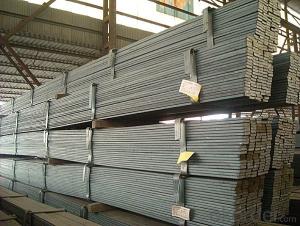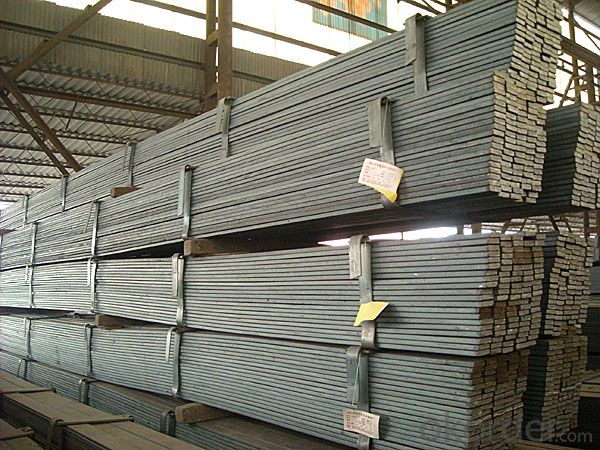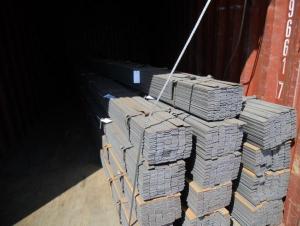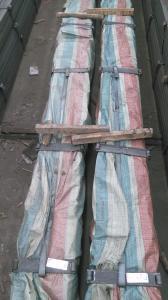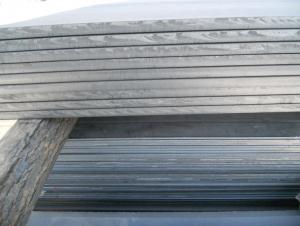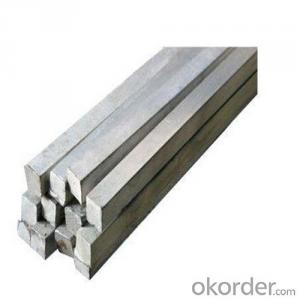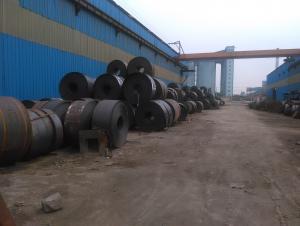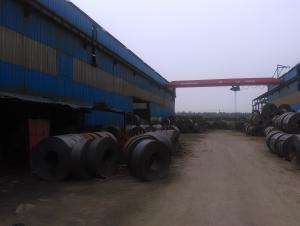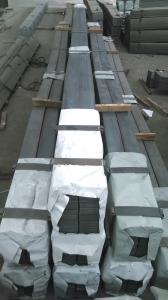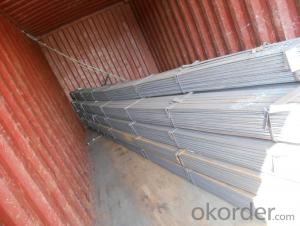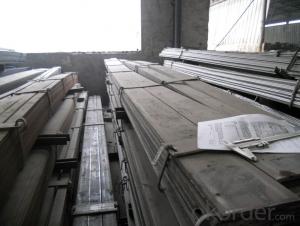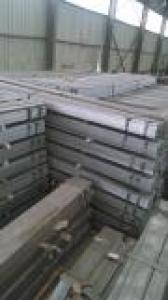Steel Flat Bar Chinese Standard Slit and Cut Form
- Loading Port:
- China main port
- Payment Terms:
- TT or LC
- Min Order Qty:
- 25 m.t.
- Supply Capability:
- 10000 m.t./month
OKorder Service Pledge
OKorder Financial Service
You Might Also Like
1. Structure of Steel Flat Bar Chinese Standard Slit and Cut Form Description:
Steel flat bar Chinese standard slit and cut form is a beam with an I-shaped cross-section. The horizontal elements of the "I" are known as flanges, while the vertical element is termed the "web". Steel flat bar Chinese standard slit and cut form is usually made of structural steel and is used in construction and civil engineering. The steel flat bar Chinese standard slit and cut form resists shear forces, while the flanges resist most of the bending moment experienced by the beam. Steel flat bar Chinese standard slit and cut form theory shows that the I-shaped section is a very efficient form for carrying both bending and shears loads in the plane of the web.
2. Main Features of Steel Flat Bar Chinese Standard Slit and Cut Form:
• Grade: Q235
• Type: Mild carbon steel
• Deflection: The stiffness of the I-beam will be chosen to minimize deformation
• Vibration: The stiffness and mass are chosen to prevent unacceptable vibrations, particularly in settings sensitive to vibrations, such as offices and libraries.
• Local yield: Caused by concentrated loads, such as at the beam's point of support.
3. Steel Flat Bar Chinese Standard Slit and Cut Form Images:
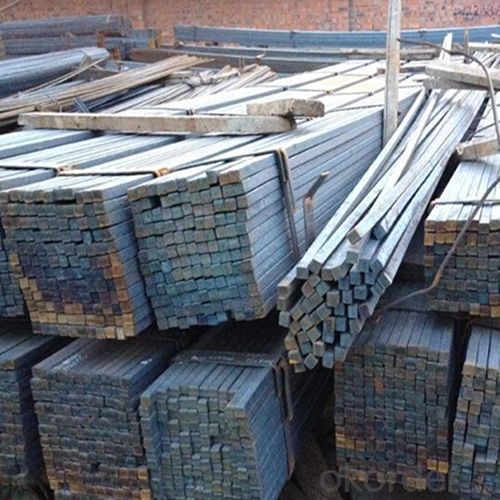
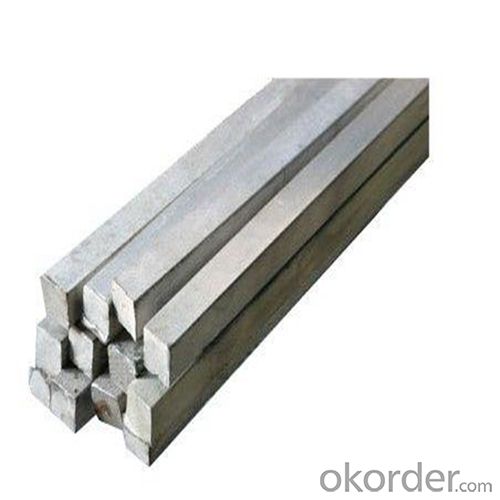

4. Steel Flat Bar Chinese Standard Slit and Cut Form Specification:
Alloy No | Grade | Element(%) | ||||
C
| Mn
| S
| P
| Si
| ||
Q235
|
B
|
0.12—0.20 |
0.3—0.7 |
≤0.045 |
≤0.045
|
≤0.3
|
Alloy No | Grade | Yielding strength point(Mpa) | Tensile strength (Mpa) | Elongation after fracture(%) | ||||||
Thickness (mm) | Thickness (mm) | |||||||||
≤16 | >16--40 | >40--60 | >60--100 | ≤16 | >16--40 | >40--60 | >60--100 | |||
≥ | ≥ | |||||||||
Q235 |
B |
235 |
225 |
215 |
205 |
375--500 |
26 |
25 |
24 |
23 |
5. FAQ
We have organized several common questions for our clients,may help you sincerely:
①Is this product same as W beam?
In the United States, the most commonly mentioned I-beam is the wide-flange (W) shape. These beams have flanges in which the planes are nearly parallel. Other I-beams include American Standard (designated S) shapes, in which flange surfaces are not parallel, and H-piles (designated HP), which are typically used as pile foundations. Wide-flange shapes are available in grade ASTM A992,[4] which has generally replaced the older ASTM grades A572 and A36.
②How to inspect the quality?
We have a professional inspection group which belongs to our company. We resolutely put an end to unqualified products flowing into the market. At the same time, we will provide necessary follow-up service assurance.
③Is there any advantage about this kind of product?
Steel I beam bar IPE has a reduced capacity in the transverse direction, and is also inefficient in carrying torsion, for which hollow structural sections are often preferred.
- Q: How strong are steel flat bars?
- Steel flat bars are known for their strength and durability. The specific strength of steel flat bars can vary depending on the grade of steel used and the dimensions of the bar. However, in general, steel flat bars are considered to be quite strong due to the inherent properties of steel, making them suitable for a wide range of structural and industrial applications.
- Q: How do steel flat bars compare to other types of steel bars?
- Steel flat bars, a type of steel bar widely used and known for their versatility, possess numerous advantages when compared to other types of steel bars. To begin with, steel flat bars provide a larger surface area compared to round bars or square bars. This expansive surface area renders steel flat bars ideal for applications requiring strength and stability, such as construction or industrial projects. Moreover, the increased surface area allows for better weight and stress distribution, resulting in steel flat bars exhibiting superior resistance to bending or warping under heavy loads. Furthermore, steel flat bars are easily fabricated and shaped, making them suitable for a wide range of applications. They can be effortlessly cut, drilled, welded, or machined to meet specific project requirements. This adaptability has made steel flat bars a favored choice among manufacturers, fabricators, and DIY enthusiasts alike. Additionally, steel flat bars possess impressive strength and durability properties. Typically crafted from carbon steel, they boast high tensile strength and overall toughness. Consequently, steel flat bars can withstand heavy loads and resist deformation more effectively than other types of bars. Furthermore, they display a heightened resistance to corrosion, making them suitable for outdoor applications or environments exposed to moisture or chemicals. In terms of cost, steel flat bars generally offer a more affordable alternative to stainless steel or alloy steel bars. This cost-effectiveness renders them an attractive option for various projects, particularly in industries requiring large quantities of steel bars. In summary, steel flat bars present numerous advantages over other types of steel bars, including a larger surface area, ease of fabrication, excellent strength and durability, resistance to corrosion, and affordability. These qualities establish steel flat bars as a popular choice across a wide range of applications, from construction and manufacturing to DIY projects.
- Q: What are the different surface finishes for steel flat bars?
- There are several different surface finishes available for steel flat bars, each with its own unique properties and benefits. Some of the most common surface finishes for steel flat bars include: 1. Hot Rolled: This is the most basic surface finish, where the steel is heated and then rolled through a series of rollers to achieve the desired shape. This finish is characterized by a rough and textured surface, with visible mill scale. It is often used for structural applications where appearance is not a primary concern. 2. Cold Rolled: In this process, the steel is rolled at room temperature, resulting in a smoother and more precise finish. Cold rolled steel flat bars have a clean and smooth surface, making them suitable for applications where aesthetics are important, such as furniture or decorative pieces. 3. Galvanized: Galvanizing is a process in which the steel flat bars are coated with a layer of zinc to protect them from corrosion. This finish provides excellent corrosion resistance and durability, making it ideal for outdoor applications or in environments with high moisture or chemical exposure. 4. Polished: Steel flat bars can also be polished to achieve a shiny and reflective surface. This finish is often used in architectural or decorative applications, where a sleek and modern appearance is desired. Polished steel flat bars can be further treated with coatings or protective films to enhance their durability and resistance to scratches or stains. 5. Brushed: Brushing is a surface treatment that creates a pattern of fine lines on the steel surface, giving it a textured and matte appearance. This finish is commonly used in applications where a decorative yet non-reflective surface is desired, such as signage or interior design. It is important to consider the specific requirements and intended use of the steel flat bars when selecting the appropriate surface finish. Each finish offers different aesthetic qualities, corrosion resistance, durability, and ease of maintenance, allowing for a wide range of options to suit various applications.
- Q: Can steel flat bars be used for making support beams or columns?
- Yes, steel flat bars can be used for making support beams or columns. Steel flat bars are versatile construction materials that are commonly used in various structural applications, including support beams and columns. They possess excellent strength and durability properties, making them suitable for bearing heavy loads and providing structural stability. Steel flat bars can be easily fabricated and welded to form the desired shape and dimensions required for support beams and columns. Additionally, their uniformity and consistent dimensions make them ideal for ensuring structural integrity in construction projects. Overall, steel flat bars are a reliable and widely used choice for making support beams and columns due to their strength, durability, and ease of fabrication.
- Q: Are steel flat bars commonly used in the construction of government buildings?
- Yes, steel flat bars are commonly used in the construction of government buildings. They provide structural support and can be used for various applications such as framing, reinforcement, and the creation of architectural features. Steel flat bars are preferred due to their strength, durability, and versatility, making them an essential component in the construction industry, including government buildings.
- Q: What are the applications of steel flat bars?
- Steel flat bars have a wide range of applications in various industries such as construction, manufacturing, and automotive. They are commonly used in the fabrication of structures, supports, and frames due to their strength, durability, and versatility. Additionally, steel flat bars are often utilized in machinery parts, equipment manufacturing, and as base plates or brackets for different projects.
- Q: Can steel flat bars be used as reinforcement in concrete structures?
- Certainly, reinforcement in concrete structures can be achieved by utilizing steel flat bars. In concrete construction, steel bars are widely employed to enhance the strength and durability of the structure. These bars are positioned within the concrete to counteract tensile forces and prevent the occurrence of cracks. When it comes to reinforcing beams, slabs, and other structural components, steel flat bars prove to be particularly advantageous as they significantly enhance the flexural strength of the concrete. Additionally, the flat shape of these bars facilitates their seamless integration with the concrete, ensuring a robust bond between the two materials. Moreover, steel flat bars are available in a multitude of sizes and grades, thereby allowing for customization to cater to the specific needs of the concrete structure.
- Q: Can steel flat bars be used for making hinges or latches?
- Indeed, hinges or latches can be crafted using steel flat bars. The utilization of steel flat bars is widespread in diverse contexts owing to their robustness, endurance, and adaptability. In the realm of hinges or latches, they furnish a dependable and robust mechanism for the act of opening and closing doors, cabinets, or other objects. The flat structure of these bars facilitates effortless installation and secure fastening to the respective surfaces. Moreover, steel boasts remarkable resistance to corrosion, rendering it suitable for employment both indoors and outdoors. In summary, the utilization of steel flat bars for fabricating hinges or latches is an exceptional choice, as it imparts stability and durability to the final product.
- Q: Can steel flat bars be used for making brackets or supports for electrical substations?
- Yes, steel flat bars can be used for making brackets or supports for electrical substations. Steel flat bars are known for their strength, durability, and load-bearing capacity, which makes them suitable for such applications. Additionally, steel is resistant to corrosion and can withstand harsh weather conditions, further enhancing its suitability for use in electrical substations.
- Q: Are steel flat bars used in the manufacturing of automotive components?
- Yes, steel flat bars are commonly used in the manufacturing of automotive components. They are often used for structural support, reinforcement, and as a base material for various automotive parts such as brackets, frames, and chassis components.
Send your message to us
Steel Flat Bar Chinese Standard Slit and Cut Form
- Loading Port:
- China main port
- Payment Terms:
- TT or LC
- Min Order Qty:
- 25 m.t.
- Supply Capability:
- 10000 m.t./month
OKorder Service Pledge
OKorder Financial Service
Similar products
Hot products
Hot Searches
Related keywords
